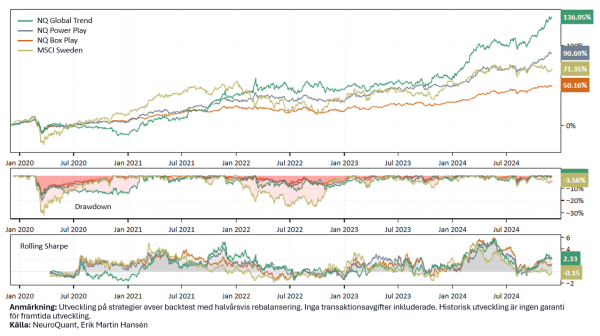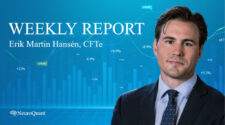Update: Investment strategies (multi assets)

We offer smart model portfolios for long-term savings, adapted to different risk levels. Our strategies help you spread your risks, reduce fluctuations and at the same time increase the possibility of good returns. Keep in mind that historical returns do not guarantee future results, and our strategies are for inspiration – not personal advice.
By diversifying our exposure to different markets and asset classes, we free ourselves from dependence on the Stockholm Stock Exchange's performance and open the door to opportunities to benefit from larger global trends. Our goal is to build capital in a stable and strategic way over the long term – without having to ride the emotional roller coaster of the stock market.
“You should have a strategic asset allocation that assumes you don't know what the future will hold.“. – Ray Dalio
Our investment strategies
We provide both strategic (passive), often called “all-weather portfolio”, and tactical asset allocation.
- Passive All-Weather Portfolio is a buy-and-hold strategy with fixed holdings, designed to perform well regardless of economic climate or market conditions. Weights are rebalanced semi-annually to maintain balance.
- A tactical allocation, on the other hand, means that the portfolio's allocation is actively and more frequently adjusted by replacing holdings and/or adjusting the weights up or down depending on market conditions.
According to backtesting, all strategies have outperformed the stock market with a higher risk-adjusted return.
Backtest 5 years (December 2019 until December 2024)
| Type | With. | CAGR | Sharpe | Vol. | MaxDD | Beta | correlation | |
| NQ Box Play | Passive all-weather portfolio | 50,2% | 8,3% | 0,94 | 7,2 | -16,3% | 0,33 | 0,75 |
| NQ Power Play | Passive all-weather portfolio | 90,7% | 13,5% | 1,38 | 8,7 | -17,1% | 0,24 | 0,48 |
| NQ Global Trend | Tactical asset allocation | 136,0% | 18,4% | 1,21 | 13,8 | -21,1% | 0,09 | 0,12 |
| NQ Tactical Diversification* | Tactical all-weather briefcase | n/a | n/a | n/a | n/a | n/a | n/a | n/a |
| MSCI Sweden | 71,4% | 11,2% | 0,56 | 17,1 | -33,0% | 1,00 | 1,00 |
Development 5 years (December 2019 until December 2024)
 Allocation
Allocation
Login required to view holdings in our model portfolios
Not a customer? Open an account to access our analytics service.
Why is there little interest in diversification?
Many private investors place greater emphasis on pure returns and are often attracted by large profit opportunities without fully considering the risk taken to achieve these results. This can be due to several factors:
- Knowledge level: Many retail investors have limited experience analyzing risk and risk-adjusted returns. They may not be familiar with metrics such as Sharpe ratio, volatility or risk-adjusted returns, and therefore focus more on absolute returns.
- Short-term focus: Private investors are sometimes more short-term in their investment behavior, which can lead them to chase quick profits without considering long-term risk management.
- Higher risk appetite or ignorance of risk: Many people have a natural risk appetite when they start investing and may therefore ignore risk adjustment measures to maximize potential returns. Sometimes it can also be a lack of understanding of how risk works and the impact it can have on a portfolio over time.
- Failure to diversify: Retail investors often have a less diversified portfolio, meaning that a single investment can have a large impact on the portfolio's overall return and risk profile. Professional investors, on the other hand, tend to use a structured asset allocation to create a more balanced risk-adjusted return.
- Lack of understanding of market cycles: Many retail investors can become over-enthusiastic during bull markets and take on too much risk, which can lead to large losses in downturns. Ambitious investors often work with risk adjustment to manage market cycles and maintain stable growth even during volatile periods.
Experienced or ambitious investors, on the other hand, tend to focus heavily on maximizing risk-adjusted returns. They work on risk management, diversification, and continuously balancing the portfolio to achieve a more stable and long-term sustainable return.

